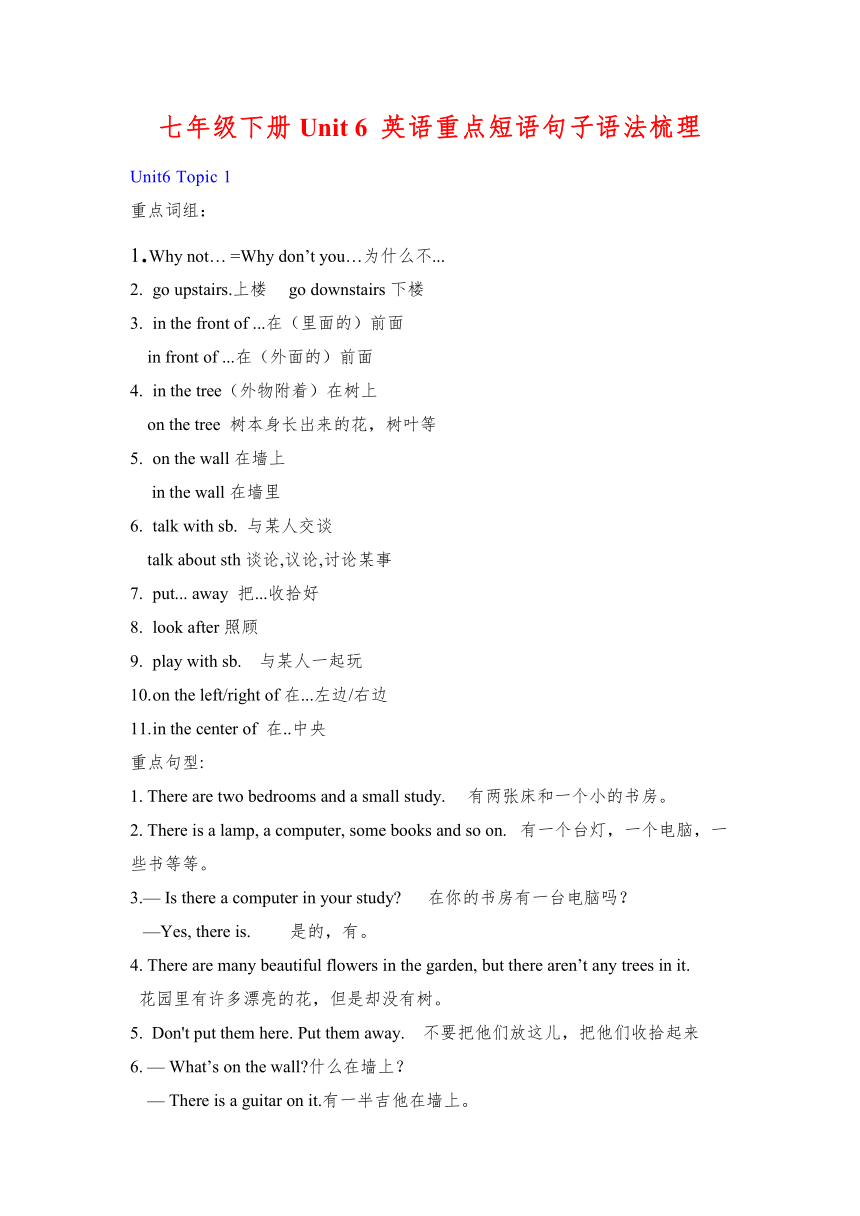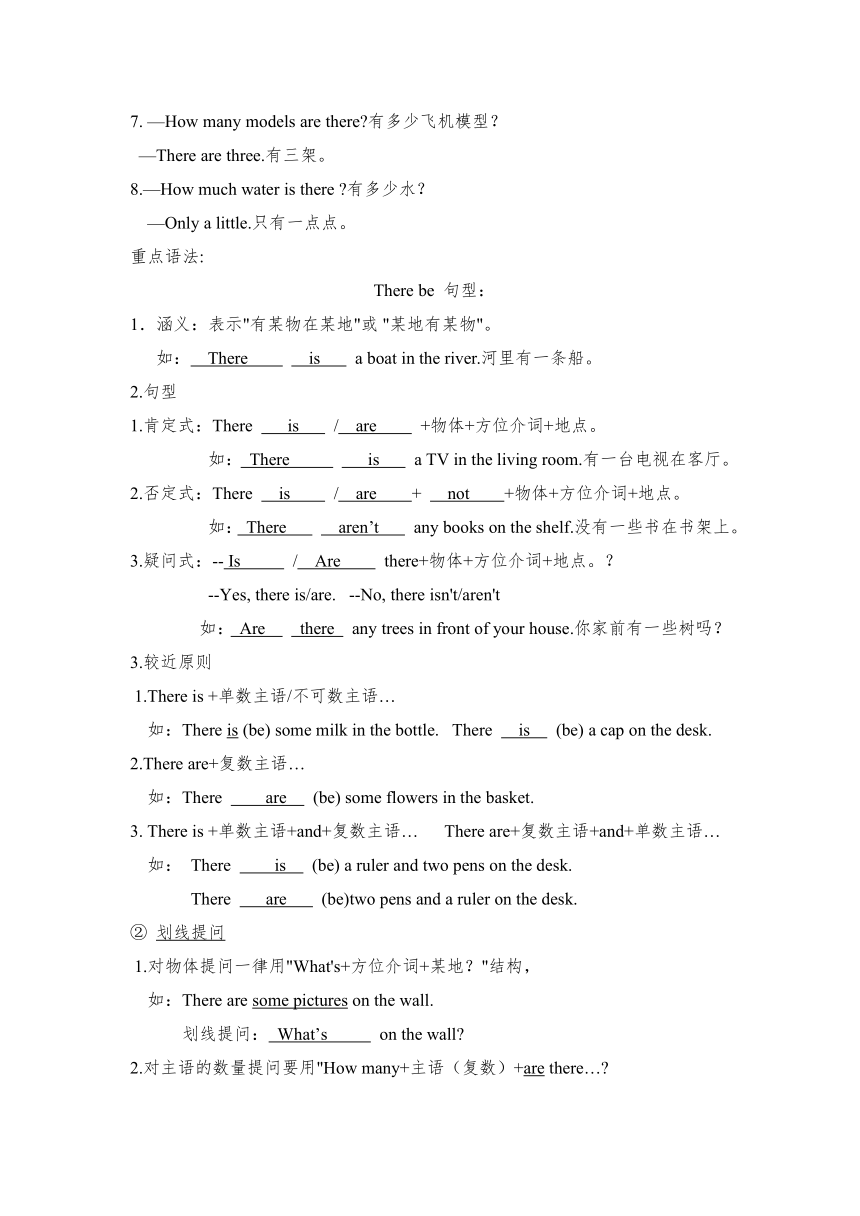Unit 6 Our local area(重点短语+句子+语法)
文档属性
| 名称 | Unit 6 Our local area(重点短语+句子+语法) |  | |
| 格式 | zip | ||
| 文件大小 | 26.5KB | ||
| 资源类型 | 试卷 | ||
| 版本资源 | 仁爱科普版 | ||
| 科目 | 英语 | ||
| 更新时间 | 2020-05-22 08:49:49 | ||
图片预览



文档简介
七年级下册Unit 6 英语重点短语句子语法梳理
Unit6?Topic 1
重点词组:
1.Why not… =Why don’t you…为什么不...
go upstairs.上楼? go downstairs下楼
in the front of ...在(里面的)前面
in front of ...在(外面的)前面
in the tree(外物附着)在树上
on the tree 树本身长出来的花,树叶等
on the wall在墙上
?in the wall?在墙里?
talk with sb. 与某人交谈
talk about sth谈论,议论,讨论某事
put... away 把...收拾好
look after照顾
play with sb. 与某人一起玩
on the left/right of在...左边/右边
in the center of 在..中央
重点句型:
1.?There are two bedrooms and a small study.??? 有两张床和一个小的书房。
2.?There is a lamp, a computer, some books and so on.???有一个台灯,一个电脑,一些书等等。??
3.—?Is there a computer in your study???????在你的书房有一台电脑吗?
???—Yes, there is.??????? 是的,有。
4.?There are many beautiful flowers in the garden, but there aren’t any trees in it.?
花园里有许多漂亮的花,但是却没有树。
Don't put them here. Put them away.?? 不要把他们放这儿,把他们收拾起来
6. —?What’s on the wall?什么在墙上?
—?There is a guitar on it.有一半吉他在墙上。
7. —How many models are there?有多少飞机模型?
—There are three.有三架。
8.—How much water is there ?有多少水?
—Only a little.只有一点点。
重点语法:
There be 句型:
1.涵义:表示"有某物在某地"或?"某地有某物"。?
如: There is a boat in the river.河里有一条船。
2.句型?
1.肯定式:There is / are +物体+方位介词+地点。?
如: There is a TV in the living room.有一台电视在客厅。
2.否定式:There is / are + not +物体+方位介词+地点。?
如: There aren’t any books on the shelf.没有一些书在书架上。
3.疑问式:-- Is / Are there+物体+方位介词+地点。??
--Yes, there is/are.? --No, there isn't/aren't?
如: Are there any trees in front of your house.你家前有一些树吗?
3.较近原则
?1.There is +单数主语/不可数主语…?
如:There is (be) some milk in the bottle.? There is (be) a cap on the desk.?
2.There are+复数主语…
如:There are (be) some flowers in the basket.?
3. There is +单数主语+and+复数主语… There are+复数主语+and+单数主语…
如: There is (be) a ruler and two pens on the desk.?
There are (be)two pens and a ruler on the desk.?
② 划线提问
?1.对物体提问一律用"What's+方位介词+某地?"结构,
如:There are some pictures on the wall.
划线提问: What’s on the wall??
2.对主语的数量提问要用"How many+主语(复数)+are there…?
How much+主语(不可数)+is there…?"
如: There are three people in my family
. 划线提问: How many people are there in your family??
There's some rice in the bag.
划线提问: How much rice is there in the bag??
Unit 6 Topic 2
重点短语:
1.?live with sb. 和某人居住在一起
? live in sp. 居住在某地
2.?look for 寻找
3.?park cars?停车
4.?keep money 存钱
5.?borrow books 借书
6.?post letters 寄信
7.?take trains? 乘火车
8.?see a doctor 看医生
9.?buy books 买书
10.?at the end of ...在……的尽头
11.?on the corner of 在…转角/拐弯处??
12.?close to?距离……近,紧挨着的
13.?far from距离……远?
14.a?lot of = lots of 许多?
重点句型:
1.--What’s your home like???????你的家是什么样的?
?? --It’s an apartment building.???? 它是一栋公寓楼。???
2.?They live in a big farmhouse in the country.?? 他们住在农村的农舍里。
3.??--What kind of home do you live in??? 你住在什么样的房子里??
???--It’s a townhouse with two floors.它是两层楼的城镇住宅。
4.?-How many floor are there in your building??? 你的房子有几层??
???--There are seven.有七层。
5.?There are many houses with big yards .?? 有许多带着大院子的房子。
6.There are many old people living here.?? 有很多的老人居住在这里。
重点语法:
“there be”句型速记
一、速记口诀
there be句型有特点,主语放在 be 后面;
单数主语用 is,复数用 are记心间①;
多个主语并列时,就近原则是关键②。
变否定,很简单,be 后要把not 添;
疑问句也不难,把 be 提到there 前③。
肯定句中用 some,否定、疑问any换④。
二、口诀解读
①There be句型的基本结构为“There be+主语(某人或某物)+地点(副词或介词短语)”,表示“某地存在某人(或某物)”,因此也叫“存在句”。当主语是不可数名词或单数名词时,be用is;当主语是复数时,be用are。
??? There is a ruler on the desk.书桌上有一把尺。
????There are four apples on the tree.(长在树上)树上有四个苹果。
②当主语是两个或两个以上的名词时,谓语动词的数要与离它最近的名词的数一致,即采用“临近原则”。
????There is an orange and some bananas in the basket.
????=There are some bananas and an orange in the basket.?
????篮子里有一个橘子和一些香蕉。
③其否定句是在be后加not。一般疑问句是将be提到句首,句末变问号。
????肯定回答用:Yes, there is/are.;
????否定回答用No, there isn’t/aren’t.
????e.g. There are some pictures on the wall.
????→There aren’t any pictures on the wall.
????→Are there any pictures on the wall?
????There is a bike behind the tree.
????→There isn’t a bike behind the tree.
????→Is there a bike behind the tree?
④在肯定句中常用some,但在变为否定句或疑问句时,要把some改为any。
????There are some fish in the water.
????→Are there any fish in the water?
Unit 6?Topic 3
重点短语:
1.?go along沿着…走
go across 穿过
turn left/right向左转/向右转??
look left/right看左边/看右边
change to变成????????????
6.?get/be?hurt受伤?????
7. lose one’s life失去某人的生命
8.?obey the traffic rules?? 遵守交通规则?????
9.?keep safe保持安全?????
10.?across from 在…对面
11. between……and 在…之间?
12.?on the first/second/third crossing?? 在第一/二/三个路口
重点句型:
1.问路
①Where is the bookstore?
②Is there a bookstore near here??
③Which is the way to the bookstore?
④How can I get to the bookstore?
⑤Could you tell me the way to the bookstore?
2.指路:
①Go along/down this road until……
Go up (Go along)this street to the end ,and you will find it on your left.
②Turn left at the first turning
﹦Take the first turning on the left.
③Go straight ahead and you will see……
④It’s about 15 kilometers away from here.
3.? --How far is it from here? (问距离) 离这有多远?
???? --It’s about ten kilometers away from here.? 离这有十千米远。
4.?Everybody must be careful and obey the traffic rules.?? 每个人一定小心并且遵守交通规则。
5.?We must stop and look both ways before we cross the road.
?? 在我们过马路之前,我们必须停下来向路的两边看。
6.?We must never play on the street. 我们绝对不能在街上玩耍。
7.?We can go when the lights are green.绿灯行。
8. We must stop when the lights are red.红灯停。
9.?It’s good to help children and old people to cross the road.?
??帮助小孩和老人过马路是一种助人为乐的行为。
重点语法:
祈使句:表示请求、命令、禁止、劝告或建议的句子,特点是省略了主语。
祈使句无主语, 主语you常省去;
动词原形当谓语, 句首加don't变否定;
●肯定结构:
1. Do型(即:动词原形(+宾语)+其它成分)。
如:Please have a seat here. 请这边坐。
2. Be型(即:Be + 表语(名词或形容词)+其它成分)。
如:Be a good boy! 要做一个好孩子!
3. Let型(即:Let + 宾语 + 动词原形 + 其它成分)。
如:Let me help you. 让我来帮你。
●否定结构:
1. Do型和Be型的否定式都是在句首加don't构成。
如:Don't forget me! 不要忘记我! Don't be late for school! 上学不要迟到!
2. Let型的否定式有两种:“Don't + let + 宾语 + 动词原形 + 其它成分”和
“Let + 宾语 + not + 动词原形 + 其它成分”。
如:Don't let him go. / Let him not go. 别让他走。
3. 有些可用no开头,用来表示禁止性的祈使句。
如:No smoking! 禁止吸烟!No fishing! 禁止钓鱼!
Unit6?Topic 1
重点词组:
1.Why not… =Why don’t you…为什么不...
go upstairs.上楼? go downstairs下楼
in the front of ...在(里面的)前面
in front of ...在(外面的)前面
in the tree(外物附着)在树上
on the tree 树本身长出来的花,树叶等
on the wall在墙上
?in the wall?在墙里?
talk with sb. 与某人交谈
talk about sth谈论,议论,讨论某事
put... away 把...收拾好
look after照顾
play with sb. 与某人一起玩
on the left/right of在...左边/右边
in the center of 在..中央
重点句型:
1.?There are two bedrooms and a small study.??? 有两张床和一个小的书房。
2.?There is a lamp, a computer, some books and so on.???有一个台灯,一个电脑,一些书等等。??
3.—?Is there a computer in your study???????在你的书房有一台电脑吗?
???—Yes, there is.??????? 是的,有。
4.?There are many beautiful flowers in the garden, but there aren’t any trees in it.?
花园里有许多漂亮的花,但是却没有树。
Don't put them here. Put them away.?? 不要把他们放这儿,把他们收拾起来
6. —?What’s on the wall?什么在墙上?
—?There is a guitar on it.有一半吉他在墙上。
7. —How many models are there?有多少飞机模型?
—There are three.有三架。
8.—How much water is there ?有多少水?
—Only a little.只有一点点。
重点语法:
There be 句型:
1.涵义:表示"有某物在某地"或?"某地有某物"。?
如: There is a boat in the river.河里有一条船。
2.句型?
1.肯定式:There is / are +物体+方位介词+地点。?
如: There is a TV in the living room.有一台电视在客厅。
2.否定式:There is / are + not +物体+方位介词+地点。?
如: There aren’t any books on the shelf.没有一些书在书架上。
3.疑问式:-- Is / Are there+物体+方位介词+地点。??
--Yes, there is/are.? --No, there isn't/aren't?
如: Are there any trees in front of your house.你家前有一些树吗?
3.较近原则
?1.There is +单数主语/不可数主语…?
如:There is (be) some milk in the bottle.? There is (be) a cap on the desk.?
2.There are+复数主语…
如:There are (be) some flowers in the basket.?
3. There is +单数主语+and+复数主语… There are+复数主语+and+单数主语…
如: There is (be) a ruler and two pens on the desk.?
There are (be)two pens and a ruler on the desk.?
② 划线提问
?1.对物体提问一律用"What's+方位介词+某地?"结构,
如:There are some pictures on the wall.
划线提问: What’s on the wall??
2.对主语的数量提问要用"How many+主语(复数)+are there…?
How much+主语(不可数)+is there…?"
如: There are three people in my family
. 划线提问: How many people are there in your family??
There's some rice in the bag.
划线提问: How much rice is there in the bag??
Unit 6 Topic 2
重点短语:
1.?live with sb. 和某人居住在一起
? live in sp. 居住在某地
2.?look for 寻找
3.?park cars?停车
4.?keep money 存钱
5.?borrow books 借书
6.?post letters 寄信
7.?take trains? 乘火车
8.?see a doctor 看医生
9.?buy books 买书
10.?at the end of ...在……的尽头
11.?on the corner of 在…转角/拐弯处??
12.?close to?距离……近,紧挨着的
13.?far from距离……远?
14.a?lot of = lots of 许多?
重点句型:
1.--What’s your home like???????你的家是什么样的?
?? --It’s an apartment building.???? 它是一栋公寓楼。???
2.?They live in a big farmhouse in the country.?? 他们住在农村的农舍里。
3.??--What kind of home do you live in??? 你住在什么样的房子里??
???--It’s a townhouse with two floors.它是两层楼的城镇住宅。
4.?-How many floor are there in your building??? 你的房子有几层??
???--There are seven.有七层。
5.?There are many houses with big yards .?? 有许多带着大院子的房子。
6.There are many old people living here.?? 有很多的老人居住在这里。
重点语法:
“there be”句型速记
一、速记口诀
there be句型有特点,主语放在 be 后面;
单数主语用 is,复数用 are记心间①;
多个主语并列时,就近原则是关键②。
变否定,很简单,be 后要把not 添;
疑问句也不难,把 be 提到there 前③。
肯定句中用 some,否定、疑问any换④。
二、口诀解读
①There be句型的基本结构为“There be+主语(某人或某物)+地点(副词或介词短语)”,表示“某地存在某人(或某物)”,因此也叫“存在句”。当主语是不可数名词或单数名词时,be用is;当主语是复数时,be用are。
??? There is a ruler on the desk.书桌上有一把尺。
????There are four apples on the tree.(长在树上)树上有四个苹果。
②当主语是两个或两个以上的名词时,谓语动词的数要与离它最近的名词的数一致,即采用“临近原则”。
????There is an orange and some bananas in the basket.
????=There are some bananas and an orange in the basket.?
????篮子里有一个橘子和一些香蕉。
③其否定句是在be后加not。一般疑问句是将be提到句首,句末变问号。
????肯定回答用:Yes, there is/are.;
????否定回答用No, there isn’t/aren’t.
????e.g. There are some pictures on the wall.
????→There aren’t any pictures on the wall.
????→Are there any pictures on the wall?
????There is a bike behind the tree.
????→There isn’t a bike behind the tree.
????→Is there a bike behind the tree?
④在肯定句中常用some,但在变为否定句或疑问句时,要把some改为any。
????There are some fish in the water.
????→Are there any fish in the water?
Unit 6?Topic 3
重点短语:
1.?go along沿着…走
go across 穿过
turn left/right向左转/向右转??
look left/right看左边/看右边
change to变成????????????
6.?get/be?hurt受伤?????
7. lose one’s life失去某人的生命
8.?obey the traffic rules?? 遵守交通规则?????
9.?keep safe保持安全?????
10.?across from 在…对面
11. between……and 在…之间?
12.?on the first/second/third crossing?? 在第一/二/三个路口
重点句型:
1.问路
①Where is the bookstore?
②Is there a bookstore near here??
③Which is the way to the bookstore?
④How can I get to the bookstore?
⑤Could you tell me the way to the bookstore?
2.指路:
①Go along/down this road until……
Go up (Go along)this street to the end ,and you will find it on your left.
②Turn left at the first turning
﹦Take the first turning on the left.
③Go straight ahead and you will see……
④It’s about 15 kilometers away from here.
3.? --How far is it from here? (问距离) 离这有多远?
???? --It’s about ten kilometers away from here.? 离这有十千米远。
4.?Everybody must be careful and obey the traffic rules.?? 每个人一定小心并且遵守交通规则。
5.?We must stop and look both ways before we cross the road.
?? 在我们过马路之前,我们必须停下来向路的两边看。
6.?We must never play on the street. 我们绝对不能在街上玩耍。
7.?We can go when the lights are green.绿灯行。
8. We must stop when the lights are red.红灯停。
9.?It’s good to help children and old people to cross the road.?
??帮助小孩和老人过马路是一种助人为乐的行为。
重点语法:
祈使句:表示请求、命令、禁止、劝告或建议的句子,特点是省略了主语。
祈使句无主语, 主语you常省去;
动词原形当谓语, 句首加don't变否定;
●肯定结构:
1. Do型(即:动词原形(+宾语)+其它成分)。
如:Please have a seat here. 请这边坐。
2. Be型(即:Be + 表语(名词或形容词)+其它成分)。
如:Be a good boy! 要做一个好孩子!
3. Let型(即:Let + 宾语 + 动词原形 + 其它成分)。
如:Let me help you. 让我来帮你。
●否定结构:
1. Do型和Be型的否定式都是在句首加don't构成。
如:Don't forget me! 不要忘记我! Don't be late for school! 上学不要迟到!
2. Let型的否定式有两种:“Don't + let + 宾语 + 动词原形 + 其它成分”和
“Let + 宾语 + not + 动词原形 + 其它成分”。
如:Don't let him go. / Let him not go. 别让他走。
3. 有些可用no开头,用来表示禁止性的祈使句。
如:No smoking! 禁止吸烟!No fishing! 禁止钓鱼!
同课章节目录
- Unit 5 Our school life
- Topic 1 I usually come to school by subway.
- Topic 2 A few students are running around the play
- Topic 3 My school life is very interesting.
- Unit 6 Our local area
- Topic 1 Is there a computer in your study?
- Topic 2 My home is in an apartment building.
- Topic 3 Which is the way to the hospital?
- Review of Units 5-6
- Unit 7 The Birthday
- Topic 1 When is your birthday?
- Topic 2 Can you sing an English song?
- Topic 3 Everyone had a good time.
- Unit 8 The seasons and the Weathe
- Topic 1 What's the weather like in summer?
- Topic 2 The summer holidays are coming.
- Topic 3 Let’s celebrate!
- Review of Units 7-8
- 旧版资料
- Unit 5 Our School Life
- Unit 6 Our Local Area
- Unit 7 The Birthday
- Unit 8 The seasons and the Weathe
- Unit 7 Celebrating the Birthday(老版本)
